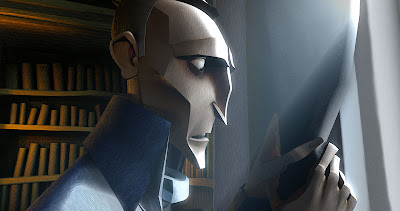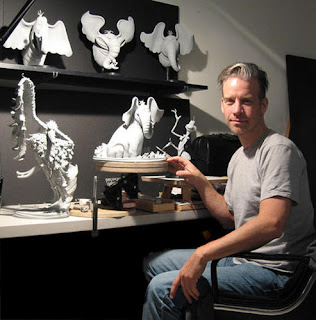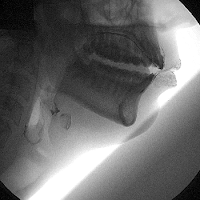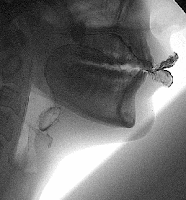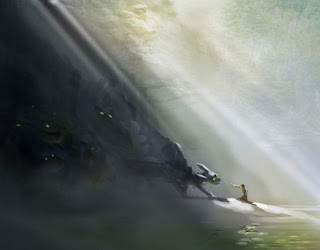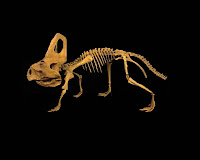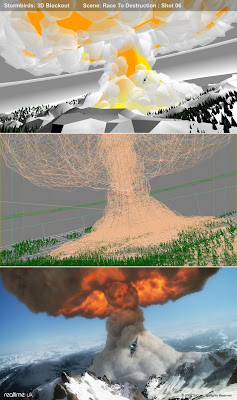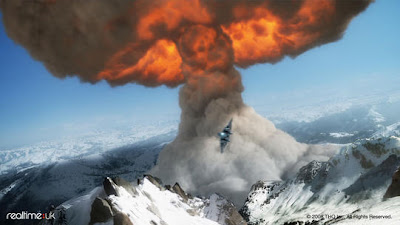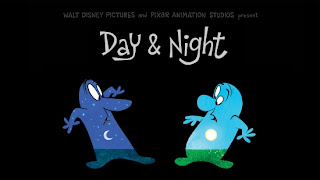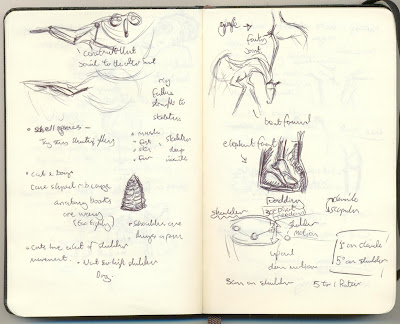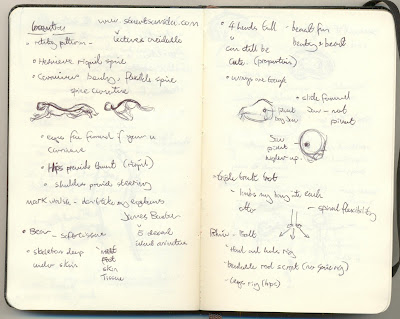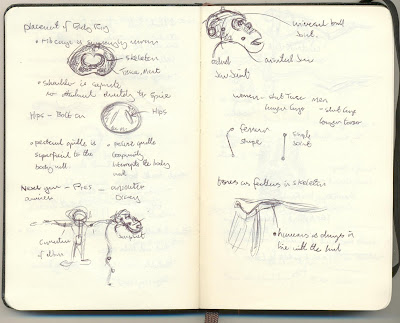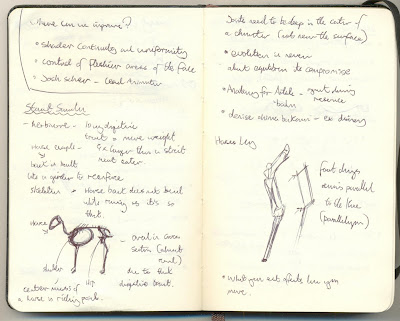Edgar Allan Poe's literary works have inspired a new animated feature "Extraordinary Tales" directed by Raul Garcia.
Currently in production by Melusine and Les Armatures, the studio responsible for The Belleville Rendezvous, the film will be made up of 5 adaptations of the writers stories including The Tell Tale Heart. The few images released so far of the film show a brilliantly distinctive look and indicate that the film may be entirely or at least partly CG so perhaps this could be a mixed media production.
This looks to be a really interesting film, whether this will be released in mainstream cinema or to the Film Festival Circuit is not known yet but I shall definitely keep an eye out for it.
Monday 29 March 2010
Saturday 27 March 2010
Michael Defeo - Blue Sky Studios (character development)
The sculptor Michael Defeo talked at Animex 2010 on behalf of Blue Sky studios.
A brilliant artist, Defeo has a great deal of experience in the industry creating the final 3D designs for the infamous Scrat and many other characters including Sid from Ice Age and Horton from Horton Hears a Who.
The talk consisted of a brief description of Michael Defeo's career path and then into the technical aspects of what contributes to a good sculpture and how to approach character when sculpting.
Michael Defeo was heavily influenced by Ray Harry Hausen and this drove him to pursue the art of model making and sculpting. He initially moved into commercial advertising with creation of stop motion puppets. The founders of Blue Sky started out on the cult hit TRON and many years later created a film called Joe's Appartment featuring singing, dancing cockroaches. This was Defeo's first big film and he created the stop motion puppets for the feature, this project led to work on the popular Alien film and a CG short named Bunny. That short gained an oscar for best animated short in 1998 and the achievement set the ball rolling for Blue Sky's following features with the Ice Age franchise, Robots and Horton Hears a Who.
So here are the more technical and practical notes, Michael stressed that reference imagery when sculpting is extremely useful and that traditional art should be a constant influence. Working professionally in this area does mean collaboration with other artists and departments so it is best to expect plenty of limitations and changes to projects and designs at the most aggravating of times, this is the typical influence business has on art.
When sculpting Michael tries to capture story moments and dynamic poses to give a high level of expression to the characters. With these poses contrasting curves are best so that the sculpt attains a good composition. Developing the 3D forms requires an understanding of the hierarchy of forms, meaning seeing planes in the cross sections of the characters shape. Starting with the general planes allows a block out of the form which which can then be worked down and detailed with greater precision later on. When Defeo sculpts he feels as though he is the character and this allows him, much like an animator, to empathise with the personality in his work.
Recently Defeo has discovered the wonders of Pixologic's ZBrush software. This has since made his traditional clay sculpting take a back seat although the general theory of sculpting remains the same. Now with ZBrush he will start with a ZSphere, its edge loops in the right places for the model, and sculpt from a side view to achieve the correct profile. Making the sculpt small on screen at certain points allows the sculptor to see how it reads better.
Michael specifically mentioned a few character design aspects while quickly walking the audience through a typical example of his work. The hair on the female bust he had modelled used a helix like shape for a twisted effect with indents applied behind the actual curl for depth, this looked brilliant. Another point was that the upper eyelids of characters should be "chunky" which is often a fault with many character designs so make your characters upper lids thick.
A massive drawback with CG was that it was stuck in the computer and there was nothing physically there to touch however now with 3D printing digital master pieces can be brought into reality through resin or plastic. The Invision 3D printer is a favourite of Michael's although the cost of the kit is well beyond many of us especially recent graduates and students. Still, a really interesting selection of images were shown of his 3D prints for Ice Age, some of which have been released as model kits publicly.
Another brilliant sculptor who wasn't mentioned in the talk but has designed for Kung Fu Panda, Ratatouille and Madagascar to name a few is Damon Bard. His professional site is: http://www.bardsculpturestudio.com/
deffinitely worth checking out his work
Michael Defeo gave a brilliant presentation and after talking to him I managed to muster a few interesting pointers on modelling in clay. The arrival of ZBrush has allowed the experimentation of ideas in 3D to be a lot easier for people like Michael however the wow factor of having something physically sculpted in front of you makes clay still a brilliant medium. I hope these notes are helpful to people, I didn't get everything down from this talk due to the sheer amount of information but hopefully I captured most of what was said. The next Animex post will be my notes from Andrew Shmidt's talk for Pixar so keep an eye out for that.
A brilliant artist, Defeo has a great deal of experience in the industry creating the final 3D designs for the infamous Scrat and many other characters including Sid from Ice Age and Horton from Horton Hears a Who.
The talk consisted of a brief description of Michael Defeo's career path and then into the technical aspects of what contributes to a good sculpture and how to approach character when sculpting.
Michael Defeo was heavily influenced by Ray Harry Hausen and this drove him to pursue the art of model making and sculpting. He initially moved into commercial advertising with creation of stop motion puppets. The founders of Blue Sky started out on the cult hit TRON and many years later created a film called Joe's Appartment featuring singing, dancing cockroaches. This was Defeo's first big film and he created the stop motion puppets for the feature, this project led to work on the popular Alien film and a CG short named Bunny. That short gained an oscar for best animated short in 1998 and the achievement set the ball rolling for Blue Sky's following features with the Ice Age franchise, Robots and Horton Hears a Who.
So here are the more technical and practical notes, Michael stressed that reference imagery when sculpting is extremely useful and that traditional art should be a constant influence. Working professionally in this area does mean collaboration with other artists and departments so it is best to expect plenty of limitations and changes to projects and designs at the most aggravating of times, this is the typical influence business has on art.
When sculpting Michael tries to capture story moments and dynamic poses to give a high level of expression to the characters. With these poses contrasting curves are best so that the sculpt attains a good composition. Developing the 3D forms requires an understanding of the hierarchy of forms, meaning seeing planes in the cross sections of the characters shape. Starting with the general planes allows a block out of the form which which can then be worked down and detailed with greater precision later on. When Defeo sculpts he feels as though he is the character and this allows him, much like an animator, to empathise with the personality in his work.
Recently Defeo has discovered the wonders of Pixologic's ZBrush software. This has since made his traditional clay sculpting take a back seat although the general theory of sculpting remains the same. Now with ZBrush he will start with a ZSphere, its edge loops in the right places for the model, and sculpt from a side view to achieve the correct profile. Making the sculpt small on screen at certain points allows the sculptor to see how it reads better.
Michael specifically mentioned a few character design aspects while quickly walking the audience through a typical example of his work. The hair on the female bust he had modelled used a helix like shape for a twisted effect with indents applied behind the actual curl for depth, this looked brilliant. Another point was that the upper eyelids of characters should be "chunky" which is often a fault with many character designs so make your characters upper lids thick.
A massive drawback with CG was that it was stuck in the computer and there was nothing physically there to touch however now with 3D printing digital master pieces can be brought into reality through resin or plastic. The Invision 3D printer is a favourite of Michael's although the cost of the kit is well beyond many of us especially recent graduates and students. Still, a really interesting selection of images were shown of his 3D prints for Ice Age, some of which have been released as model kits publicly.
Another brilliant sculptor who wasn't mentioned in the talk but has designed for Kung Fu Panda, Ratatouille and Madagascar to name a few is Damon Bard. His professional site is: http://www.bardsculpturestudio.com/
deffinitely worth checking out his work
Michael Defeo gave a brilliant presentation and after talking to him I managed to muster a few interesting pointers on modelling in clay. The arrival of ZBrush has allowed the experimentation of ideas in 3D to be a lot easier for people like Michael however the wow factor of having something physically sculpted in front of you makes clay still a brilliant medium. I hope these notes are helpful to people, I didn't get everything down from this talk due to the sheer amount of information but hopefully I captured most of what was said. The next Animex post will be my notes from Andrew Shmidt's talk for Pixar so keep an eye out for that.
Friday 26 March 2010
XRay Speech Analysis
While browsing animation resources I came across Christine Ericsdotter's XRay analyses of the human head in motion.
These 2 sequences show the placement of the jaw and teeth in the head while talking and opening the mouth, they have already aided my rigging and I imagine could help many other animators/modellers/riggers.
Hope these are helpful to people.
The link for the GIFs with motion is: http://hundertmarkblog.de/christine-ericsdotter-x-ray-analyses-of-speech/
Enjoy!
These 2 sequences show the placement of the jaw and teeth in the head while talking and opening the mouth, they have already aided my rigging and I imagine could help many other animators/modellers/riggers.
Hope these are helpful to people.
The link for the GIFs with motion is: http://hundertmarkblog.de/christine-ericsdotter-x-ray-analyses-of-speech/
Enjoy!
Tripp Hudson - Framestore
Apologies for not posting sooner but anyhow here are the notes I took from Framestore's talk at Animex with representative Tripp Hudson, the Senior VFX Producer. The talk was focussed particularly on the studio's contributions to the recent blockbuster Avatar.
Framestore retrieved incomplete and in some case untouched scenes from WETA workshop, the studio responsible for Lord of the Rings and District 9. The workload was too high for WETA alone so Framestore jumped on board project. Avatar was filmed in stereoscopic this meant matchmoving twice, animating twice and rendering twice to create the desired effect this was an an epic task. The introductory shots to the planet "pandora" including the interior dropship shots and the landing of the dropship at basecamp were Framestores responsibility as well as the first shots of the tank like human exoskeletons.
The visors in the interior dropship shots were perhaps the most simple of Framestore's duties with their addition of reflective visors on the corp's helmets however this still meant carefully calculated reflection information. On the basecamp shots over 400 assets needed to be tracked and composited including digi-double soldiers, buildings and vehicles. The sheer scale and detailing of this production meant this one shot required even distant buildings to be modelled inside out at photo realistic level. Obviously with this amount of detail a substantial number of layers were rendered and required for effective compositing of the final edit.
In production "Dailys" was a term given to the daily previews of the composites which were in progress. These were arranged so that the team could assess very regularly the progression of a shot, prototype 3D glasses were worn that allowed an unfinished shot three dimensionality. James Cameron as a director was praised by Framestore, his technical knowledge of occlusion and render composites was extraordinary for a man of his position. Contact between the studio and Cameron was via satellite link video meetings scheduled at awkward times where the London and L.A time difference meant staff presenting in the early hours of the morning. Nuke and Maya were the major softwares used by Framestore in the production of Avatar, showing just how much potential these programmes have.
The Framestore talk was not very long but I felt that I managed to note down most of what was said. If anyone wishes to delve further into the Framestore contributions to Avatar or purely the company and its other work the studio's site holds alot of cool info: http://www.framestore-cfc.com/
I also have a link to brilliant BBC coverage featuring Tripp Hudson of Framestore showing, at a basic level, how shots were created for Avatar.
I Hope to put up my Blue Sky notes soon, a brilliant talk so keep an eye out for Michael Deffeo on my next Animex based post.
Framestore retrieved incomplete and in some case untouched scenes from WETA workshop, the studio responsible for Lord of the Rings and District 9. The workload was too high for WETA alone so Framestore jumped on board project. Avatar was filmed in stereoscopic this meant matchmoving twice, animating twice and rendering twice to create the desired effect this was an an epic task. The introductory shots to the planet "pandora" including the interior dropship shots and the landing of the dropship at basecamp were Framestores responsibility as well as the first shots of the tank like human exoskeletons.
The visors in the interior dropship shots were perhaps the most simple of Framestore's duties with their addition of reflective visors on the corp's helmets however this still meant carefully calculated reflection information. On the basecamp shots over 400 assets needed to be tracked and composited including digi-double soldiers, buildings and vehicles. The sheer scale and detailing of this production meant this one shot required even distant buildings to be modelled inside out at photo realistic level. Obviously with this amount of detail a substantial number of layers were rendered and required for effective compositing of the final edit.
In production "Dailys" was a term given to the daily previews of the composites which were in progress. These were arranged so that the team could assess very regularly the progression of a shot, prototype 3D glasses were worn that allowed an unfinished shot three dimensionality. James Cameron as a director was praised by Framestore, his technical knowledge of occlusion and render composites was extraordinary for a man of his position. Contact between the studio and Cameron was via satellite link video meetings scheduled at awkward times where the London and L.A time difference meant staff presenting in the early hours of the morning. Nuke and Maya were the major softwares used by Framestore in the production of Avatar, showing just how much potential these programmes have.
The Framestore talk was not very long but I felt that I managed to note down most of what was said. If anyone wishes to delve further into the Framestore contributions to Avatar or purely the company and its other work the studio's site holds alot of cool info: http://www.framestore-cfc.com/
I also have a link to brilliant BBC coverage featuring Tripp Hudson of Framestore showing, at a basic level, how shots were created for Avatar.
I Hope to put up my Blue Sky notes soon, a brilliant talk so keep an eye out for Michael Deffeo on my next Animex based post.
Monday 22 March 2010
Hans Rijpkema - Rhythm and Hues
Hans Rijpkema represented Rhythm and Hues, the leading Visual Effects Studio, at Animex 2010.
The talk shed light on their upcoming projects and the expansion of the studio from LA to Mumbai and Kuala Lumpur. Rhythm and Hues have 22 years experience in the industry and have contributed heavily to the industry standard of VFX today. Currently the studio, amongst many other projects, are in the process of creating a Yogi Bear feature and putting the final touches on the blockbuster reinvention of the A-team.
Rhythm and Hues are in a changing Industry, the bar has been raised and now more complex characters, higher photo realism, shorter time frames and increasingly detailed backgrounds are all a film necessity. These factors require the studio to change its approach and the working style they use, these 3 key points help them determine their production cycles:
The talk shed light on their upcoming projects and the expansion of the studio from LA to Mumbai and Kuala Lumpur. Rhythm and Hues have 22 years experience in the industry and have contributed heavily to the industry standard of VFX today. Currently the studio, amongst many other projects, are in the process of creating a Yogi Bear feature and putting the final touches on the blockbuster reinvention of the A-team.
Rhythm and Hues are in a changing Industry, the bar has been raised and now more complex characters, higher photo realism, shorter time frames and increasingly detailed backgrounds are all a film necessity. These factors require the studio to change its approach and the working style they use, these 3 key points help them determine their production cycles:
- Technical Capabilites
- Audience Expectations
- Client Expectations ( these points directly influence one another)
Production cycles vary from production to production, they grow and shrink depending on dedicated workforce size and deadlines. It is hard for studios to maintain a talent pool and over half of Rhythm and Hues workforce are contracted freelancers on temporary contracts. This allows the studio to get out of company health care plans for freelance artists. Another way in which they avoid health care costs is by outsourcing to England and it's heavily built VFX Industry in Soho, in doing this there are also tax incentives in the form of rebates. The industry, which was focussed in Hollywood and the Bay area in LA, is now global due to the financial incentives for the American film industry. With this spread of technology comes the application of visual effects to an increasing level of productions and the growth of smaller studios into major competitors for Rhythm and Hues.
The nature of the industry has historically been the growing competition between studios in re-establishing the standard of visual effects, this prompts the giant leaps in technology we see from motion picture to motion picture. To do this studios need to have improving technology in the pipeline being researched and tested while current technologies are in practice on current projects. Rhythm and Hues have established new facilities abroad in India for example to allow these current technologies to be in practice and allow the LA facility to focus more on technological development. This business plan was described by Hans in great detail but in short the costs of living are considerably cheaper in the new facility's countries, lowering the cost of man-power but allowing all employees a very comfortable wage in relation to their economy. This globalisation has meant that the search for talent has become global and therefore more artists than ever are recruited in VFX than ever before. The rich cultures of the countries are embraced at the studios and make for new inspiration and influence on the art in visual effects. The challenges Rhythm and Hues look to face now are:
- a New Industry
- Severe shortage of trained talent
- lack of exposure at new facilities to high quality work
- the establishment of a new facility in China
I shall most likely add to this post at a later point with more detail on Rhythm and Hues working on a global scale from facility to facility. Some detail on what was expected from trainee staff was somewhere in my notes as well so hopefully all this will be up soon. Thanks for reading and remember to follow this blog if you are interested in the upcoming posts from Animex 2010.
Thursday 18 March 2010
Dr Stuart Sumida - Biology Consultant "How to Train Your Dragon" (Dreamworks)
Another Stuart Sumida post and this one is specifically Dinosaur based with elements of Dragon. Stuart was brought on board for "How To Train Your Dragon" due to his encyclopaedic knowledge of anything and everything dinosaur and their similarities to what mythically a dragon should be. With no real dragon's around Stuart was the next best thing to get Dreamwork's dragons moving realistically.
Staurt Sumida gave a talk that followed dinosaurs through animation history. starting with the most important Gerty the dinosaur by Winsor Mckay and leading on through Disney's Fantasia and "the right of spring". Stuart remarked on how incredibly the stegosaurus's back plates were precisely right in their placement in Fantasia whilst science only very recently found that they were stood in this postion after slating the film for misrepresentation on its release. Another example of Disney prediction of science was the feathered dinosaur featured in Fantasia, now named "Archaeoptrics". Disney were the first to find feathers on dinosaurs, this is a brilliant fact that I will revel in telling people.
Jurassic Park, a major contributor to the popularity of dinosaurs in film gave new life and realism to the prehistoric reptiles. The dinosaurs of Jurassic Park in Stuart's and of course my opinion are brilliant and the film brought fame to Raptors who were relatively unknown before. Bob Kurtz animator of a dinosaur short in the 60's created the Mr DNA sequence for the first Jurassic park. The Franchise did hold some inaccuracies which Stuart has spotted including the Bracheasaurus of the 1st film jumping up on its hind legs, this is physically impossible and its sheer weight would have broken its legs. Another is the Spinosaurus of the 3rd film and its supposed conflict with the TRex. The TRex would have owned the Spinosaur, its scale was exaggerated in the film and the creature was in fact a fish eater so would not have eaten meat. These are interesting points but film does not always have to be accurate in its science. Disney's CG film Dinosaur featured an Oviraptor that raided dinosaur nests and feasted on eggs. Science has found that it's fossils, laid near eggs, were due to their nurturing of eggs and not diet. Night at the Museum was one of Stuart's best examples of dinosaur anatomy, this same TRex model was then built on by studio Rhythm and Hues when creating Land of the Lost the recent Will Ferrel film.
Stuart went on to List his top 10 Dinosaurs of Animation:
We now base our Dragon concept on a hybrid of:
Staurt Sumida gave a talk that followed dinosaurs through animation history. starting with the most important Gerty the dinosaur by Winsor Mckay and leading on through Disney's Fantasia and "the right of spring". Stuart remarked on how incredibly the stegosaurus's back plates were precisely right in their placement in Fantasia whilst science only very recently found that they were stood in this postion after slating the film for misrepresentation on its release. Another example of Disney prediction of science was the feathered dinosaur featured in Fantasia, now named "Archaeoptrics". Disney were the first to find feathers on dinosaurs, this is a brilliant fact that I will revel in telling people.
Jurassic Park, a major contributor to the popularity of dinosaurs in film gave new life and realism to the prehistoric reptiles. The dinosaurs of Jurassic Park in Stuart's and of course my opinion are brilliant and the film brought fame to Raptors who were relatively unknown before. Bob Kurtz animator of a dinosaur short in the 60's created the Mr DNA sequence for the first Jurassic park. The Franchise did hold some inaccuracies which Stuart has spotted including the Bracheasaurus of the 1st film jumping up on its hind legs, this is physically impossible and its sheer weight would have broken its legs. Another is the Spinosaurus of the 3rd film and its supposed conflict with the TRex. The TRex would have owned the Spinosaur, its scale was exaggerated in the film and the creature was in fact a fish eater so would not have eaten meat. These are interesting points but film does not always have to be accurate in its science. Disney's CG film Dinosaur featured an Oviraptor that raided dinosaur nests and feasted on eggs. Science has found that it's fossils, laid near eggs, were due to their nurturing of eggs and not diet. Night at the Museum was one of Stuart's best examples of dinosaur anatomy, this same TRex model was then built on by studio Rhythm and Hues when creating Land of the Lost the recent Will Ferrel film.
Stuart went on to List his top 10 Dinosaurs of Animation:
- Gertie
- Fantasia Dinosaurs
- Ceratopsaurs of "Dinosaur" by Disney
- "Grumpy" TRex of Land of the Lost
- TRex skeleton Night at The Museum
- Jurassic Park
- Original King Kong TRex
- Stop motion 10,000 years BC dinosaurs
- CG King Kong dinosaurs
- Bob Kurtz Animated Dinosaurs
- crocodiles
- dinosaurs
- pterosaurs
- bats
- birds
Crocodiles are especially special in this list due to their galloping runs. A crocodile will fly through the air as they run which is terrific reference for dragon animation due to their similarities in body shape. The film Reign of Fire focussed more on the Bird/Bat influence and ultimately produced a more graceful and wing orientated dragon. A pet peave of dragon design for Stuart is the addition of a hook on the elbow, this is not a factor to any existing creatures anatomy and serves no purpose on the limb if it did. That concludes the little dragon information Stuart Sumida gave at this talk or at least the information i managed to jot down on paper. He finished with his personal top 5 dragons of Animation
- Mushu of Disney's Mulan
- Maleficent of Disney's Sleeping Beauty
- Vermithrax of Dragon Slayer
- Reign of Fire
- Hungarian Horntail of Harry Potter
I hope this interesting to people. If anyone is thinking of creating a dinosaur or dragon for an animation then all of the resources mentioned above are invaluable. I can do my best to put you through to Stuart Sumida if you do have any design or rigging problems that you really seem stuck with. I shall post more on Dreamworks when I eventually get to Mark Osbourne's talk in my notes.
CineMe
A friend of mine Joe Haynes co-directs CineMe, a film community that promotes up and coming film producers/directors/animators.
Joe has recently posted on their blog about my site so I thought I'd return the favour. CineMe holds great promotional events every few months, screening the best of their featured films for audiences in the south west of England. A brilliant site and I hope you guys check it out.
Their next event that I hope to attend is on the 15th of April at The Picture House, Bristol so anyone with a fascination of film, you know where to be. http://mycineme.co.uk/
Their next event that I hope to attend is on the 15th of April at The Picture House, Bristol so anyone with a fascination of film, you know where to be. http://mycineme.co.uk/
Wednesday 17 March 2010
Phil Shoebottom - Realtime UK (Part2)
Here is the 2nd part to the notes I made at the RealtimeUK presentation by Phil Shoebottom. I shall start with the Environment layout system that RealtimeUK have in place. Basically this works similarly to the traditional Disney Multi-Plane camera in that the environment is broken down into 3 planes with a back plate, projection painting onto procedural or low detail models and then actual modelled and textured assets. This approach to the environment allows realistic parallaxing. Realtime's passion is for fast paced, vehicle based game cutscenes and promotional renders so this approach especially works when an environment is moving past the camera at 100's of miles per hour. Layered matte paintings are vital for this system to work and save the modelling of every asset in a shot's background. Below is an example of a matte paintings integration into a final shot notice the painting's actual size, this allows camera panning
Another way to cut down on the modelling time is to re-use assets from previous models, with Realtime, their constant use of vehicles allows for wheels, wings and engines to be copied over to new projects to save time. As mentioned previously procedural rock creation is used for environmental modelling, a low poly mesh is generated, mapped (box mapped/planar mapped) and then subdivided.
The Animation is generated in passes with the pipeline running alongside the animation process. This means the client can see a film at the specified length from the early stages and identify each level of progress in turn. Here is a breakdown of the animation Passes and what they involve:
1st Pass
Another way to cut down on the modelling time is to re-use assets from previous models, with Realtime, their constant use of vehicles allows for wheels, wings and engines to be copied over to new projects to save time. As mentioned previously procedural rock creation is used for environmental modelling, a low poly mesh is generated, mapped (box mapped/planar mapped) and then subdivided.
The Animation is generated in passes with the pipeline running alongside the animation process. This means the client can see a film at the specified length from the early stages and identify each level of progress in turn. Here is a breakdown of the animation Passes and what they involve:
1st Pass
- Blockout models used
- No secondary movement
- Main action pinned
- Finalised cameras
- Final edit
- Blockout models replaced
- Secondary animation
- Explosions added
- Damage added
- (Hold back on final renders for the client's "wow" factor)
- Finished Environments- matte paintings combined
- Mattes Split (parallaxing)
- Animation merged
- Model and shader updates applied
- Scene passed for FX
All of the production is in 3DS MAX, XSI and composited in After Effects.
Fume FX is used alot in their most recent projects for explosions.
a great example of an explosive shot involves a nuclear explosion. This used 2 particle effects (particle flow system), a rotating pallete system applied to a torus and a cone.
The lighting rigs and render settings are taken from previous projects as the benchmark and tweaked from one project to the next for proven performance. 4 rigs are needed in total, lighting and shaders are tweaked, Global Illumination is baked to static objects to cut render time. A single frame will take an average of 2 hours to render when split across 50 machines processing power. When eventually brought into After-effects the colour matching, film grain, vignets and exposure filters are applied and they finally produce the desired shot.
This was a brilliant presentation, It made me realise the industry hasn't totally shifted to Maya and has prompted me to get into Max a little more. I hope my notes are useful to people and i hope to post more of the Animex speakers soon. Keep me posted with any comments about the notes i'm putting up.
Tuesday 16 March 2010
Human Art
A friend, Yanir Kleiman, spotted this brilliant article that is amazing visually. These people are actually body painted in acrylic to give the impression of them being painted characters.
http://www.mymodernmet.com/profiles/blogs/hyperrealistic-acrylic-body
The artist is Alexa Meade, I have never seen anything quite like this before and would love to try this out but have no faith that i would do the concept justice. It just looks stunning and I hope you guys are inspired and flick through these images.
http://www.mymodernmet.com/profiles/blogs/hyperrealistic-acrylic-body
The artist is Alexa Meade, I have never seen anything quite like this before and would love to try this out but have no faith that i would do the concept justice. It just looks stunning and I hope you guys are inspired and flick through these images.
Phil Shoebottom - Realtime UK (Part1)
RealtimeUK are an animation studio based in Lancashire and London, their projects include the highly impressive Motostorm E3 demo from 2005 and more recently work on the Stormbirds promotional cutscenes.
Phil Shoebottom represented RealtimeUK North with a lengthily and extremely informative talk outlining his path into the industry and the production processes and pipeline used within the studio. Phil came from a Fine Art background and gained a BA in Creative Visualisation. He graduated from Teesside in 2003 and gained employment in technical Visualisation with a basis in engineering projects he moved onto games and had his first break on the game Big Mother Truckers. He by 2005 was with RealtimeUK as a junior Artist and through considerable amounts of hard work and earning respect amongst his peers has risen to senior lead artist. The Studio itself was founded in 1996 and is a CG production house with a small crew but many responsibilities. There are 25 full-time employees at the studio with freelancers hired in on larger projects. When watching certain examples of their work its hard to believe such a small studio is behind the visuals.
The team pipelines that the studio have in place allow specialism but it does help to be a generalist and not to rely on the entirety of the team for a project to go ahead. From project to project the pipeline alters and even small projects require one, here is an example pipeline i managed to quickly jot down in my notes:
Phil Shoebottom represented RealtimeUK North with a lengthily and extremely informative talk outlining his path into the industry and the production processes and pipeline used within the studio. Phil came from a Fine Art background and gained a BA in Creative Visualisation. He graduated from Teesside in 2003 and gained employment in technical Visualisation with a basis in engineering projects he moved onto games and had his first break on the game Big Mother Truckers. He by 2005 was with RealtimeUK as a junior Artist and through considerable amounts of hard work and earning respect amongst his peers has risen to senior lead artist. The Studio itself was founded in 1996 and is a CG production house with a small crew but many responsibilities. There are 25 full-time employees at the studio with freelancers hired in on larger projects. When watching certain examples of their work its hard to believe such a small studio is behind the visuals.
The team pipelines that the studio have in place allow specialism but it does help to be a generalist and not to rely on the entirety of the team for a project to go ahead. From project to project the pipeline alters and even small projects require one, here is an example pipeline i managed to quickly jot down in my notes:
- Script/ Act List
- Concept Art/Storyboarding
- Animatic
- Speed Paintings
- Scene Blockout
- Matte plane Holders + Asset Creation
- Asset Creation requires Rigging, Animation, Cache
- Scene Build (compiled of both Mattes + Assets)
- Scene Finishing + Effects
- Final Render
- Compositing + Effects
- Final Edit + Sound
Hope this pipeline example helps people to understand the workflow and order within RealtimeUK. An interesting point is that there are no specialised riggers in-house so this requires generalist staff to understand the technicalities of rigging. Here is the way in which the studio handle a brief:
- A session with the team and youtube references to find influences.
- Idea generating sessions (brainstorming/mindmaps)
- Concept Work
- Concept Key Frames
The studio has over a decades experience in the industry and has learnt how best to handle and predict the outcome of projects. their lesson is that once you know the deadline to work backwards. Scheduling comes with experience and making an educated guess at potential complications in a projects allows foresight to tackle the obstacles head on. The key to achieving a deadline is to predict the pitfalls and overlook the aspects that can be overlooked.
The studio have traditionally blocked out with library models allowing a professional but quick visualisation to send to clients. This procedure can sometimes cut out the need for storyboard all together, saving time and money. These examples of cutting corners and remaining presentable influence the development of my own projects.
The asset creation takes on the whole around 12 weeks. A design will be supplied in many cases by the client and then once concept art has been approved the two will act as the direction of the asset. Modeling can be inspired by airfix kits in the case of their more vehicle orientated work, for their scale and precise realistic details. Textures and early shaders are then applied and demo renders are sent of approval by the client.
At this point I am around half way through my notes from the RealtimeUK talk so part 2 will be on its way soon. Hope this is helpful to people, I feel that this information and advice is a very realistic portrayal of the exciting and high octane pipeline that the industry expects from studios.
Monday 15 March 2010
Day & Night
I've been taking an interest in some of the leaked information on Pixar's short Day & Night for a few months now. There was speculation that some dinosaur concept art shown in the backgrounds of publicity shots was associated with this film however with this recently released image this seems a little unlikely.
Many film based blogs and sites have raised awareness of this new image and are lead to believe that perhaps this could be a drawn Pixar short rather than their traditional CG approach. This is going to be the short shown alongside Toy Story 3 and I am equally excited to see both of them. This now raises the question where does this dinosaur concept work come into play now?
Here's the brief synopsis of the film for anyone else with a love of Pixar Shorts-
"When Day, a sunny fellow, encounters Night, a stranger of distinctly darker moods, sparks fly! Day and Night are frightened and suspicious of each other at first, and quickly get off on the wrong foot. But as they discover each other's unique qualities--and come to realize that each of them offers a different window onto the same world--the friendship helps both to gain a new perspective."
Many film based blogs and sites have raised awareness of this new image and are lead to believe that perhaps this could be a drawn Pixar short rather than their traditional CG approach. This is going to be the short shown alongside Toy Story 3 and I am equally excited to see both of them. This now raises the question where does this dinosaur concept work come into play now?
Here's the brief synopsis of the film for anyone else with a love of Pixar Shorts-
"When Day, a sunny fellow, encounters Night, a stranger of distinctly darker moods, sparks fly! Day and Night are frightened and suspicious of each other at first, and quickly get off on the wrong foot. But as they discover each other's unique qualities--and come to realize that each of them offers a different window onto the same world--the friendship helps both to gain a new perspective."
Paul Wells: Author & Director of Animation at Loughborough Univeristy
Paul Wells presented the Animation Talk event at Animex 2010 as he has before in previous years. He gave an introductory talk named "I will not be a footsoldier in Jim Cameron's army". A powerful statement aimed at the popular film Avatar.
Apologies for the lack of Animex posts over the past week or so but I shall pick up where I left off. Paul's talk was focussed on the evolution of animation and its potential to grow as a genre. Stating "animation is art for adults" he remarked on how the film industry is increasingly appealing to an adult orientated audience. Film's such as Up, as well appealing to children, are becoming increasingly deep in their narrative and emotional content. This is in part due to Disney's revival and recent partnership with Pixar. The retro survivalist instinct of cinema is obvious with remake of popular franchises a common occurrence. This looking back to look forward makes sense and a great deal can be learnt from reinterpreting stories however with films like Avatar, blatantly cloning classic narratives like Pocahontas (Dances with Wolves) and passing them off as original is not beneficial to the film industry. Re Inventing cinema is important and with the 3D revolution hitting mainstream cinema looks to be tackling the piracy problem well. The problem with this technology is that films can rely on this solely to attract an audience and lack any kind of substance. Tim Burton's very recent Alice in Wonderland is a nice remake but again proves that cinema is running dry on original ideas. I find this personally of great advantage to newcomers in the industry, one strong and original idea could break this mould and gain mass appeal.
Back to the Disney revival and with Princes and the Frog, Disney has reclaimed its position as a successful drawn animation studio. They have set a new agenda to back localised television studios in thier animation productions. an example of this is Tinga Tinga Tales an African made children's series. A brilliantly constructive output for Disney and demonstrates how Disney is broadening its ideas.
So here is a low-down of the Animation Industry now according to Paul Wells for the next generation of industry.
Apologies for the lack of Animex posts over the past week or so but I shall pick up where I left off. Paul's talk was focussed on the evolution of animation and its potential to grow as a genre. Stating "animation is art for adults" he remarked on how the film industry is increasingly appealing to an adult orientated audience. Film's such as Up, as well appealing to children, are becoming increasingly deep in their narrative and emotional content. This is in part due to Disney's revival and recent partnership with Pixar. The retro survivalist instinct of cinema is obvious with remake of popular franchises a common occurrence. This looking back to look forward makes sense and a great deal can be learnt from reinterpreting stories however with films like Avatar, blatantly cloning classic narratives like Pocahontas (Dances with Wolves) and passing them off as original is not beneficial to the film industry. Re Inventing cinema is important and with the 3D revolution hitting mainstream cinema looks to be tackling the piracy problem well. The problem with this technology is that films can rely on this solely to attract an audience and lack any kind of substance. Tim Burton's very recent Alice in Wonderland is a nice remake but again proves that cinema is running dry on original ideas. I find this personally of great advantage to newcomers in the industry, one strong and original idea could break this mould and gain mass appeal.
Back to the Disney revival and with Princes and the Frog, Disney has reclaimed its position as a successful drawn animation studio. They have set a new agenda to back localised television studios in thier animation productions. an example of this is Tinga Tinga Tales an African made children's series. A brilliantly constructive output for Disney and demonstrates how Disney is broadening its ideas.
So here is a low-down of the Animation Industry now according to Paul Wells for the next generation of industry.
- 82% of animators are self employed freelancers, £15,000 starting wage.
- Individuals must be articulate in using their strongest skills.
- Think about the relationship between past,present and future. History/ Theory/ Practice
- Treat successful film makers as inspiration and promoters of your own aspirations. Don't just copy
- Have Fun!
I found This talk pretty inspiring and after reading Paul Wells's material over the course of my studies many of his ideas on cinema and animation came through in his talk. This was not first time i have met Paul, he lectured at my university a few years ago and i managed to pick his brain on a few things. His book "The Fundamentals of Animation" is definitely worth a read. Hope this is of some interest to you guys and there's plenty of animation orientated notes yet to be posted up.
Friday 12 March 2010
Website finally up!
Hey, just a quick post to say that
http://www.jamesense.co.uk/
is finally up and running, It has my university projects along with a gallery of stills for you to enjoy, hope to have a lot more to post up on the site over the next few months.
I have neglected to post any of the animation specific Animex notes over the past week so expect them soon.
Hope you enjoy the website and get in contact if you have any criticisms over the site.
It's my first so i'm sure something's gone a skew.
http://www.jamesense.co.uk/
is finally up and running, It has my university projects along with a gallery of stills for you to enjoy, hope to have a lot more to post up on the site over the next few months.
I have neglected to post any of the animation specific Animex notes over the past week so expect them soon.
Hope you enjoy the website and get in contact if you have any criticisms over the site.
It's my first so i'm sure something's gone a skew.
Wednesday 3 March 2010
Dr Stuart Sumida - Biology Consultant (Pixar, Dreamworks, Rhythm and Hues): Part 3
Hey so here is the last instalment of the Stuart Sumida notes, Some of this is really useful some of it's a little random but could come in useful one day. Schell Games were another of Stuart's clients which I found intriguing as they are responsible for a selection of the animatronics and roller coasters at Epcot. The knowledge of this kind of biology is obviously extremely useful to engineers.
Cats and Dogs are commonly animated characters and over the years certain features have arisen as vital to their believability. A cat's shoulders have plenty of flexibility and contribute a lot to their unique movement, they are situated at a higher point than a dogs shoulders. Both species have a cone shaped rib cage which defines their form and is useful to include in any characterisation.
Here is a random fact, an elephants foot is almost human like in bone structure, the actual shape of the elephants leg is due to the padded cushion of tissue the elephant has under the heel. This is shown in the sketch above partially, a funny thing to find out though. On a more character rigging tangent the movement of the human arm, or any primate like being, relies on a ratio of 5 to 1 where the clavicle moves only slightly whilst the shoulder (scapula) moves to greater degree. This is always difficult to replicate in a rig but with driven keys or inputs through a connection editor this ratio of movement could be achieved.
Stuart showed a few examples of joint diagrams from Adalbert I. Kapandji written work's as physiology expert. I will most likely look into purchasing "the physiology of joints" which seems to hold a lot of useful information. Some of last few points made were that the ball and plate bone in your knee is not as secure as you may think. The ball will roll to and fro over the surface held in place by muscle and tissue but when the knee is bent too far due to the shaped flat of the tibia the joint will result in bone collision or dislocation. This is useful to show the limits the leg has in its movement and that the a knee's rotation is not anchored to 1 axis.
A final fact, the cheek bone, bottom of eye socket and ear hole on the human head are precisely the same level so when character designing/modelling this might come in handy. Stuart Sumida gave a great workshop and hopefully I can attend Animex 2011 and attend another of these. Hope some of this is of help I shall be able to focus on the Animators of Animex now so these next few blogs will be great.
Tuesday 2 March 2010
Dr Stuart Sumida - Biology Consultant (Pixar, Dreamworks, Rhythm and Hues): Part 2
Here's part 2 of the notes I will post on the Stuart Sumida workshop. Locomotion was the prepared presentation for this session however quite a few of us had unrelated questions that Stuart was all too happy help us with so if notes are a little random at times that would be why.
As previously stated the rigidity of a herbivore's spine is considerably more than a carnivore's. In the cheetah sketch above this demonstrates the range of curvature it's spine has when when running. to provide the agility of it movement the shoulder's provide steering whilst the hips provide thrust from a bolted position. Another interesting thing with carnivores is that their eyes face forward whilst a herbivores are positioned on the side of its head. This is basically due to a carnivore's hunt for prey requiring focus whilst a herbivore requires extreme peripheral vision to identify potential attackers in its surroundings.
The skeleton of a creature lies at its core, a bear has meat, fat, tissue and skin as well as fur all layered over the skeletal structure. This means that when imagining the skeleton for a fictional character these factors need to be taken into consideration to ensure that characters have believable movement. The Beast of "Beauty and the Beast" took anatomical reference from bears so that it would move correctly. The key characterised/stylised element was his 4 head tall proportion, allowing him to be threatening whilst retaining a "cute" factor. The caricaturing of proportion in characters is common and was an issue for the movement of the dog "Bolt". His legs would collide when walking and to combat this it meant changing the rigging to allow more flexibility in the spine, enough for the hind legs to alternate from the front on a cycle to give each leg room to stretch on a triple track trot. The Hips are an area of the body which require the pelvic cradle to lie just under the skin, allowing more freedom for the legs to move
The character when rigged in T Pose should have the arm's humerus always in line with the hand and should have its elbows lower than its shoulders to obtain the right curvature when animated. Female characters generally have a short torso and longer legs whilst male characters have longer torso's and shorter legs, this is useful when designing any character.
A interesting point and key to my work at this moment time is the orientation of the jaw and where its pivots are. The jaw can slide forward and backwards due to the muscle running from the ears downward, the actual pivot of its rotation is found a little higher. This requires, when rigging, 2 joints for each of these movements so the character has believable mouth movements.
I shall write up the remaining notes form Stuart Sumida's workshop in the next blog, hope these are of use to people, it's great knowing this same info is being used by the guys in the major studios.
As previously stated the rigidity of a herbivore's spine is considerably more than a carnivore's. In the cheetah sketch above this demonstrates the range of curvature it's spine has when when running. to provide the agility of it movement the shoulder's provide steering whilst the hips provide thrust from a bolted position. Another interesting thing with carnivores is that their eyes face forward whilst a herbivores are positioned on the side of its head. This is basically due to a carnivore's hunt for prey requiring focus whilst a herbivore requires extreme peripheral vision to identify potential attackers in its surroundings.
The skeleton of a creature lies at its core, a bear has meat, fat, tissue and skin as well as fur all layered over the skeletal structure. This means that when imagining the skeleton for a fictional character these factors need to be taken into consideration to ensure that characters have believable movement. The Beast of "Beauty and the Beast" took anatomical reference from bears so that it would move correctly. The key characterised/stylised element was his 4 head tall proportion, allowing him to be threatening whilst retaining a "cute" factor. The caricaturing of proportion in characters is common and was an issue for the movement of the dog "Bolt". His legs would collide when walking and to combat this it meant changing the rigging to allow more flexibility in the spine, enough for the hind legs to alternate from the front on a cycle to give each leg room to stretch on a triple track trot. The Hips are an area of the body which require the pelvic cradle to lie just under the skin, allowing more freedom for the legs to move
The character when rigged in T Pose should have the arm's humerus always in line with the hand and should have its elbows lower than its shoulders to obtain the right curvature when animated. Female characters generally have a short torso and longer legs whilst male characters have longer torso's and shorter legs, this is useful when designing any character.
A interesting point and key to my work at this moment time is the orientation of the jaw and where its pivots are. The jaw can slide forward and backwards due to the muscle running from the ears downward, the actual pivot of its rotation is found a little higher. This requires, when rigging, 2 joints for each of these movements so the character has believable mouth movements.
I shall write up the remaining notes form Stuart Sumida's workshop in the next blog, hope these are of use to people, it's great knowing this same info is being used by the guys in the major studios.
Monday 1 March 2010
Dr Stuart Sumida - Biology Consultant (Pixar, Dreamworks, Rhythm and Hues): Part 1
Double Fine were the last of the games industry to talk at Animex, paving way for the workshops and animation talk event. Stuart Sumida gave the following morning workshop that I attended. The sheer amount of information thrown our way over the few hours we had meant that I probably didn't note down everything but i'll do my best to re-interpret what I got down on paper.
I am just over a third of the way through these notes so expect 2 more blogs on Dr Sumida. hope this is helpful for people interested in the whole rigging thing or simply for animation purposes.
Above is one of the first images shown, it demonstrates using socks how different mammals have evolved with similar heel joint chains to humans but with vastly different positioning. I was completely unaware that horses for example had a heel placed half way up the hind leg but this brilliantly communicates the concept.
Another early point was the difference in the body shape and flexibility of carnivores and herbivores. A carnivore has a much shorter digestive tract than a herbivore due to meat being much quicker to breakdown and vegetation taking longer. A good example is that of a horse having a digestive tract 4 times the size of a strict meat eater. This difference in size allows a meat eater to be slim and lean giving considerably quicker and flexible movement. On the subject of horses thheir backbone is much like a rigid girder that maintains a stiff form at all times, this allows horses to be ridden and not phased by the weight of the rider. their centre of mass is at riding point also as shown in the diagram/sketch in my notes above.
A schoolboy error of character rigging and skeleton concept is bones being placed to close to the surface of the skin. bones are centred deep within the tissue. if bones are not correctly placed then joint rotation will be wrong. Another bone issue is the understanding of the leg. the foot always remains parallel to the knee due to the parallelogram system mid-leg. this can also be seen in arms and as shown above in bird's wings.
I am just over a third of the way through these notes so expect 2 more blogs on Dr Sumida. hope this is helpful for people interested in the whole rigging thing or simply for animation purposes.
The non copyright presentation materials are available in PDF form on stuart's site http://www.stuartsumida.com/
Subscribe to:
Posts (Atom)

